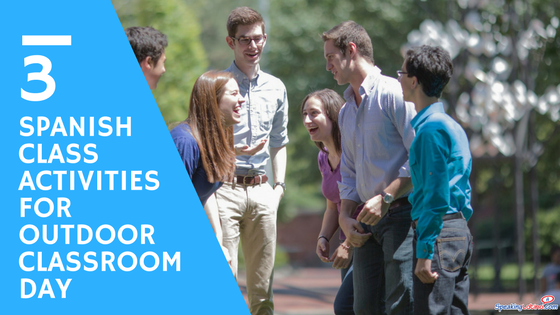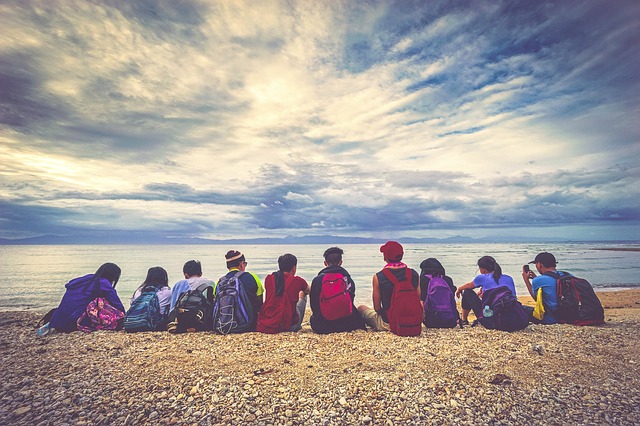
In some parts of the world, a beautiful spring day in May usually means wistful and wriggly students, itching to look out the classroom window, longing for some time outdoors. One day in May, why not take your Spanish class outside for some outdoor learning to celebrate Outdoor Classroom Day?
What is Outdoor Learning Anyway?
Many educators today are talking a lot about 21st-century skills and how best to give students opportunities to practice leadership, cooperation, and communication. Outdoor learning offers teachers a great way to incorporate these kinds of skills into an experience that allows students to think playfully and spontaneously while learning.
In general, outdoor learning experiences often emphasize social skills, teamwork, and resilience, which are all necessary for the successful navigation of real-life situations. No matter the subject area, the learning objectives ask that students work together to accomplish a task or to think creatively about the solution to an unusual challenge.
As well, outdoor learning allows students to cultivate an appreciation for nature and the environment, both of which are relevant issues today. Spending time outdoors also improves students’ health by giving them opportunities to move and to be in the open air. Outdoor learning has been studied by researchers everywhere in America and abroad, and the numbers don’t lie: outdoor education is definitely valuable.
Taking Your Spanish Class Outside

So how to take your students outside and keep the focus on Spanish? First of all, anticipate their excitement and loosen up your expectations. Plan a lesson that focuses on informal interactions that suit the informal outdoor setting, like using the tú form in different ways or practicing age-appropriate slang from different Spanish-speaking countries. Embrace their excitement and have some fun; your students will learn more than you expect.
Also, consider combining forces with colleagues in other departments. Outdoor learning presents lots of interdisciplinary opportunities to get students working together. Science teachers and art teachers in particular often work outdoors as messy experiments and art materials are sometimes better managed outside, so see if there’s a joint lesson you can create with them that works for your curriculum.
Before taking your students outside for the first time, check to make sure your higher-ups are comfortable with this approach to learning. They may need to check with parents and other important parties before giving you the go-ahead. As well, consider the experience you want to give your students from their side of things; are they all physically able to go outside and do the activity? Do you need to be mindful of allergic reactions to things like bee stings? Develop a backup plan in case any students feel anxious for any reason.
Here are three fun outdoor activities that just might work for you and your students. Read the descriptions all the way through before telling your students about them; they all require a bit of preparation on your end, but that’s a requirement for any successful lesson, indoor or out.
3 Outdoor Activities for Your Spanish Students: Fun for All Levels!
 1. Nature Vocabulary: A Photo Essay
1. Nature Vocabulary: A Photo Essay
Learning objective: Students will learn new vocabulary words by taking pictures of words and phrases as they appear outdoors.
How to do this activity: Before starting this activity, assess your students’ level of knowledge and prior learning around nature vocabulary. Then, create appropriate vocabulary lists of nature words that are identifiable in the areas around your school where the students will be taking photos. If your students are elementary-school age, you can even read a book out loud to them that contains nature vocabulary in Spanish to warm them up and generate excitement.
Also, as this activity depends on the availability of tech gadgets in your classroom such as digital cameras or cell phones with cameras, check to see what resources are available before starting this activity. Determine which students have such devices and are willing to use them, or if the school has a few cameras to loan out to classrooms, and then pair students up or divide them up into small groups of three.
Make sure you assign roles in advance to avoid any confusion or competitive behavior amongst your students; various roles might include: word pro (with a dictionary), photographer (the owner of the device), naturalist (leads pair/group to examples of the vocabulary words).
Set students free in their groups with their devices and word lists for the class period, and for homework, assign students to compile their photos onto a PowerPoint or document to present the rest of the class.
(Alternatively, if you do not have any photographic equipment available to you, or your students are too young to be trusted with expensive devices, turn the photo essay into a drawing activity! Students will still get the benefits of being outdoors and working together while learning.)
 2. La Cocina del Sol: Solar Cooking
2. La Cocina del Sol: Solar Cooking
Learning objective: Students will practice teamwork when following instructions in Spanish to create a solar oven and cook themselves a Smores snack.
How to do this activity: Before beginning this lesson, translate these instructions on how to create a solar oven from English into Spanish using the imperative in either the tú form or the usted form, depending on which form you would like to emphasize with this lesson.
Prepare the materials the students will need before the class meeting time, and divide everything up according to how many groups you will have working during your class period.
At the start of the activity, show the students the materials they will be using, divide them into teams of your design, and introduce the activity only minimally so that students will have to figure out for themselves how these diverse materials will come together. Allow them to use a dictionary and to write down their translations in English if that is helpful, and stand back and see how well they cooperate!
 3. Retratos: Self-Portraits with ‘Found Objects’
3. Retratos: Self-Portraits with ‘Found Objects’
Learning objective: Students will learn or review vocabulary around body parts and personality descriptors and practice writing skills in Spanish.
How to do this activity: Use this lesson to either introduce students to new Spanish adjectives and nouns or to reinforce prior learning. Decide in advance which words have priority and how many are suitable for your students, depending on their age and their level of Spanish. At the beginning of the class period, meet students briefly to explain to them the artistic concept of the found object and to give them the list of vocabulary words you would like them to learn during this lesson.
Instruct students that they have twenty minutes to go outside and find natural objects that they will use to create their own self-portraits, and explain that the vocabulary lists are to be used as inspiration for these choices. Encourage creativity for the best results; the more random the connection between the found object and the facial feature, for example, the better!
Once students have found their objects, they will use the rest of the class period to put together their self-portraits using other art materials you will provide for them. For homework, ask students to describe their self-portraits in a written artist’s statement and require them to use at least ten new vocabulary words from their list correctly.
